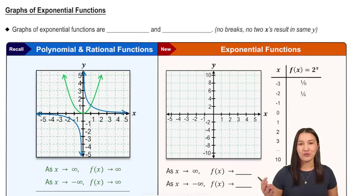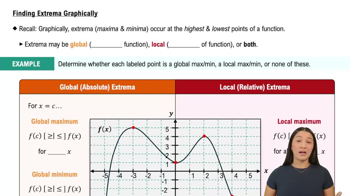Table of contents
- 0. Functions7h 52m
- Introduction to Functions16m
- Piecewise Functions10m
- Properties of Functions9m
- Common Functions1h 8m
- Transformations5m
- Combining Functions27m
- Exponent rules32m
- Exponential Functions28m
- Logarithmic Functions24m
- Properties of Logarithms34m
- Exponential & Logarithmic Equations35m
- Introduction to Trigonometric Functions38m
- Graphs of Trigonometric Functions44m
- Trigonometric Identities47m
- Inverse Trigonometric Functions48m
- 1. Limits and Continuity2h 2m
- 2. Intro to Derivatives1h 33m
- 3. Techniques of Differentiation3h 18m
- 4. Applications of Derivatives2h 38m
- 5. Graphical Applications of Derivatives6h 2m
- 6. Derivatives of Inverse, Exponential, & Logarithmic Functions2h 37m
- 7. Antiderivatives & Indefinite Integrals1h 26m
- 8. Definite Integrals4h 44m
- 9. Graphical Applications of Integrals2h 27m
- 10. Physics Applications of Integrals 3h 16m
- 11. Integrals of Inverse, Exponential, & Logarithmic Functions2h 34m
5. Graphical Applications of Derivatives
Intro to Extrema
Problem 4.1.77a
Textbook Question
Explain why or why not Determine whether the following statements are true and give an explanation or counterexample.
a. The function f(x) = √x has a local maximum on the interval [0,∞).
 Verified step by step guidance
Verified step by step guidance1
To determine if the function f(x) = √x has a local maximum on the interval [0, ∞), we first need to understand what a local maximum is. A function f(x) has a local maximum at a point x = c if there exists an interval (a, b) containing c such that f(c) ≥ f(x) for all x in (a, b).
Next, consider the behavior of the function f(x) = √x. As x increases from 0 to ∞, the value of √x also increases. This suggests that the function is monotonically increasing on the interval [0, ∞).
To further analyze, we can take the derivative of f(x) to examine its critical points. The derivative f'(x) = (1/2)x^(-1/2) is positive for all x > 0, indicating that the function is increasing on its entire domain.
Since the function is increasing and has no points where the derivative is zero or undefined (other than at x = 0, where the derivative is undefined but the function is still increasing), there are no local maxima on the interval [0, ∞).
Therefore, the statement that the function f(x) = √x has a local maximum on the interval [0, ∞) is false. The function does not have a local maximum because it continuously increases without reaching a peak.
 Verified video answer for a similar problem:
Verified video answer for a similar problem:This video solution was recommended by our tutors as helpful for the problem above
Video duration:
2mPlay a video:
Was this helpful?
Key Concepts
Here are the essential concepts you must grasp in order to answer the question correctly.
Local Maximum
A local maximum of a function occurs at a point where the function's value is greater than the values of the function at nearby points. To determine if a function has a local maximum, one typically examines the first derivative to find critical points and the second derivative to assess concavity. In the context of the given function, understanding local maxima is essential to evaluate its behavior over the specified interval.
Recommended video:

The Second Derivative Test: Finding Local Extrema
Derivative and Critical Points
The derivative of a function provides information about its rate of change and is used to find critical points, where the derivative is zero or undefined. These points are potential candidates for local maxima or minima. For the function f(x) = √x, calculating the derivative helps identify whether there are any points in the interval [0, ∞) where the function reaches a local maximum.
Recommended video:

Critical Points
Behavior of the Function on the Interval
Analyzing the behavior of the function on the specified interval is crucial for determining the presence of local maxima. For f(x) = √x, one must consider how the function behaves as x approaches 0 and as x increases towards infinity. Understanding the overall trend of the function helps in concluding whether it can attain a local maximum within the given interval.
Recommended video:

Graphs of Exponential Functions

 5:58m
5:58mWatch next
Master Finding Extrema Graphically with a bite sized video explanation from Callie
Start learning





